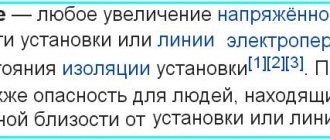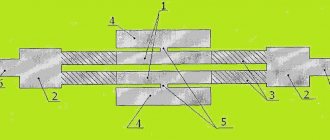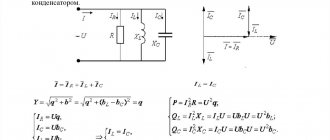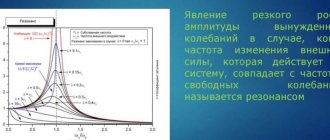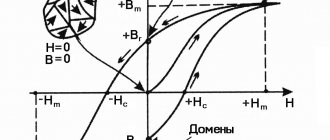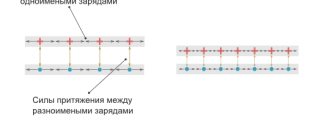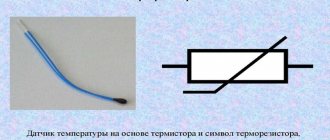Updated July 23, 2022 498 Author: Dmitry Petrov
Hello, dear readers of the KtoNaNovenkogo.ru blog. Back in school, in physics class, we studied what resonance is. But, unfortunately, this knowledge was not always presented in a form conducive to assimilation.
Therefore, today I want to very briefly remind you what resonance is, how it arises, and what types of resonance (and not only in the field of physics) are distinguished.
And, of course, all this will be told in the simplest possible terms using examples that everyone can understand. It will be interesting, don’t switch...
Resonance is...
The concept of resonance was first introduced in the 16th century by Galilio Galei, when he was studying the work of pendulums and musical strings.
Translated from Latin, the word “resonance” literally means “ I respond ” and is a physical phenomenon in which one’s own oscillatory movements become forced and increase their amplitude, thus responding to environmental influences.
In simple words, resonance is a response to a certain stimulus from the outside. This is the synchronization of oscillation frequencies (the number of oscillations per second) of a certain system and the external force acting on it, which entails an increase in the amplitude of oscillations of this system.
Resonance can be described as follows:
- imagine a certain physical body that is either in a state of absolute rest or makes amplitude movements of a certain frequency;
- this body suddenly begins to be influenced by a certain external force that has its own amplitude and frequency;
- if the frequencies of the body and the external force coincide, then the amplitude of the body will begin to increase.
For example , everyone knows how a swing “works”. First, you make a sharp push with your feet from the ground, and the swing begins to move back and forth. If you do not interfere with this process, then after a while they will stop.
But if, while sitting on them, you adapt to their movement with your whole body (neither faster nor slower), then the amplitude of the movements of the swing will begin to increase on its own. In this case, you, or rather your movements, are an external influence, a compelling force, with the help of which the swing soars higher.
Even the smallest external influence can increase the amplitude of movements of a certain system many times over when their frequencies coincide. From the example of a swing: a small child can swing an adult even with a very large weight if he adapts to the movement of the swing.
To better understand what resonance is, let's look at its antonym. It is the word “ dissonance ” (from the Latin “discordant”), which means discrepancy, discrepancy.
Let’s take a swing again as an example: if you start jerking it sharply and chaotically back and forth, the smooth, swinging vibrations will soon disappear and the swing will stop. Another simple example: if you go outside in a fur coat in the summer, it will be dissonant, since the weather does not match your outfit.
Resonant circuit calculation
It must be remembered that the phenomenon represented by current resonance requires very competent and careful calculation of the resonant circuit. It is especially important to perform a correct and accurate calculation when there is a parallel connection, which will prevent the development of interference within the system. In order for the calculation to be correct, it is necessary to determine the power indicators of the electrical network. The average standard power that is dissipated under the conditions of a resonant circuit can be expressed in terms of rms current and voltage.
Under resonance conditions, the standard power factor is unity, and the calculation formula is:
Calculation formula
In order to correctly determine zero impedance under resonance conditions, you will need to use the standard formula:
Resonance curves
The resonance of the vibrational frequency is approximated by the following formula:
Resonance of the oscillatory circuit
In order to obtain the most accurate data from the formulas, it is recommended not to round off all values obtained during the calculation process. Some physicists calculate the values of the resonant circuit in accordance with the method of vector diagram of active current quantities. In this case, competent calculation and correct configuration of devices guarantees decent savings under the condition of alternating current.
Resonant circuits are used primarily to isolate a signal at the desired frequencies as a result of filtering other signals, so independent circuit calculations must be extremely accurate.
Quality factor
In any physical oscillatory system, you can measure the degree of its responsiveness - a value called quality factor and represents the level of response intensity.
Different indicators of this value lead to different consequences:
- With a low degree of quality factor (or response), the existing system is unable to maintain forced oscillations for a long time and will gradually return to its own oscillations;
- A high quality factor in some cases can be dangerous, since intense resonance will certainly lead to the destruction of the physical body that is affected from the outside.
For example, if you don’t just stand on the middle of a board thrown across a wide river, but make swinging movements (up and down), then most likely you will soon find yourself in the water, since the board will break at the point where you were.
Application
Almost all power electrical engineering uses just such an oscillatory circuit, say, a power transformer. The circuit is also necessary for setting up the operation of a TV, capacitive generator, welding machine, radio receiver; it is used by the “matching” technology of television broadcast antennas, where you need to select a narrow frequency range of some of the waves used. The RLC circuit can be used as a band-pass filter, notch filter, for low-pass or high-pass distribution sensors.
It will be interesting➡ Thermal relay for an electric motor
Resonance is even used in aesthetic medicine (microcurrent therapy) and bioresonance diagnostics.
Types and examples of resonance
The phenomenon of resonance rightfully belongs to physics, since it was discovered by it and initially described only physical phenomena.
However, today this concept is used in a variety of spheres of life.
In this regard, we can distinguish its different types:
- Mechanical - the above-mentioned swing, the swinging of the bell “tongue”, the resonance of the bridge from a passing train or soldiers walking along it “in step”, etc.
- Acoustic – an example is the sound resonance used in playing musical instruments, such as guitar, balalaika, lute.
They all have a body and it was invented for a reason: the sound that the string makes when it is plucked goes inside the body. There it resonates with the walls, which leads to its amplification. Therefore, the sound quality directly depends on the quality of the material from which the instrument is made and even on the varnish with which it was coated. - Electrical – the coincidence of the frequency of the external voltage with the natural frequency of the electrical circuit through which the current flows.
- Public – a vivid response of the public to an event, phenomenon or situation. We are talking about a reaction that turned out to be similar among the majority of people. For example, the pension reform of 2022 caused a loud, sharp, negative resonance among the citizens of our country.
- Cognitive resonance is a coincidence of views and opinions.
For example, you met someone: as a result, you have a positive impression of the person. Why is this so? The whole point is that during the conversation you found a lot in common with him, his values and judgments turned out to be close to you, hence the sympathy, which is a consequence of resonance. From a philosophical point of view, the phenomenon is defined as the unanimity of two souls in a sensory context.
Mobile phones, microwave ovens, televisions, echoes in the mountains, sonorous singing in the bathroom - the phenomenon in question is present everywhere.
What it is
Current resonance is a type of state of an electrical circuit when the general appearance of current indicators coincides in phase with the voltage level, and the reactive power is zero or it is presented in active form.
. Current resonance
This scenario is typical for alternating current and has not only positive properties, but also some undesirable consequences. Thus, thanks to resonance, radio technology, automation and wire telephony work, but at the same time, overvoltages and malfunctions in the electrical system occur.
Definition from the textbook
Mysterious house
In “Stories about Old Moscow” by A. Vyurkov, a house is described that sounds like a scary voice. The main character of the work, Ivan Pavlovich, decided to get rich by fraud. He hired a team of masons to build him an apartment building and did not pay them the full amount promised. Soon the tenants began to leave the hotel one after another, because they were frightened by the evil spirits that howled in an inhuman voice. Ivan Pavlovich turned to the police, and the policemen remained in ambush for the night. They suffered the same fate as the tenants. Eerie sighs and howls were heard in the empty rooms. The law enforcement officers left the building in horror with the scary brownie.
Ivan Pavlovich was left without money and without tenants. He had nothing to pay the interest on the loan, so his property and himself were seized. As time passed, one of the contractors revealed to Ivan Pavlovich the secret of the mystical house. It turns out that the deceived workers decided to take revenge: they walled up empty bottles in the wall, which sounded with every gust of wind, scaring the guests.
What does sound depend on?
The more the speed of sound in air and stone differs, the better the reflection. Thus, in granite sound diverges at a speed of 4 × 103 m/s, in air - 3.3 × 102 m/s. Consequently, a small amount of energy will be released into the air, and the main part will be “closed” inside the stone. The “singing” block lies on other stones; it has a weak acoustic connection with the ground, because it touches the ground only in a few places. It turns out that the sound cannot go into the ground. Such objects that can contain vibrational energy within themselves are called resonators. What happens in the middle of the “singing” stone upon impact? The waves are reflected many times from its walls, decreasing or increasing with sound resonance. Amplification occurs when a wave, having been reflected, returns in the same phase in which it began its journey.
The room as a resonator
Indoor sound quality is especially important for theaters and philharmonic societies. There is even a special section of acoustics - architectural acoustics. It solves the problems of designing halls with good audibility. The “right” room is itself a resonator. Such halls have rounded ceilings and walls, thanks to which the sound reaches every viewer and listener.
It should be noted that the shape of the room is concave, not convex. The latter is not suitable, because when the wave is reflected at an angle, most of the sound is scattered and does not return. With the concave shape of the walls, the sound returns almost along the same trajectory as it propagates, that is, it reaches every point in the hall with virtually no loss.
Musical instruments
A guitar or violin string by itself does not sound very loud and is unlikely to be heard in a concert hall. The sound is amplified many times thanks to the body of the instrument - the resonator. Both the bell of wind instruments and the body of stringed and keyboard instruments - for example, the soundboard of a piano - are resonators. They collect weak sounds and increase their amplitude to the main sound (based on the swing principle). As a result, the instrument sounds loud, and the timbre, depth, softness or sharpness of the tone also depend on the resonator.
Sound reflection
Sound resonance is possible due to wave reflection. Let's consider this property of sound in more detail. The acoustic wave, having reached an obstacle, which can be any body, returns back. The familiar echo is a wave reflected from a distant object. Why remote? The point is that the obstacle must be located far enough for a person to distinguish between the sound from the source and the reflected sound. So, in a medium-sized room, for example, in an apartment room, there will be no echo. This is because the time after which the wave, reflected from the walls, returns, is too short. Despite this, you can clearly hear that the sound is booming and loud.
If you cover all the walls with carpets or cover them with other soundproofing materials, the sound will become dull, dry, and even unpleasant. In cases where sonority is important, you need to take care of what the acoustic wave will be reflected from. There will be no sound resonance without this.
"Singing" stone
Not far from Baku, the capital of Azerbaijan, there is a desert with the famous “singing” stone. It is so famous that it received the name “Stone Tambourine”. This amazing block has the property that if you hit it with a stone, the sound will be as loud and clear as a bell. How does physics explain this example of sound resonance?
The impact leads to short-term deformation - immediately sound waves run in all directions from the point of collision. The size of the stone does not affect the speed of their divergence. However, the wave can propagate freely only in unlimited space. But we know that stone and air have boundaries (where they touch). When the wave reaches the boundary, it partially passes into another medium - from stone into air. The remaining part of the acoustic energy is reflected in the opposite direction.
